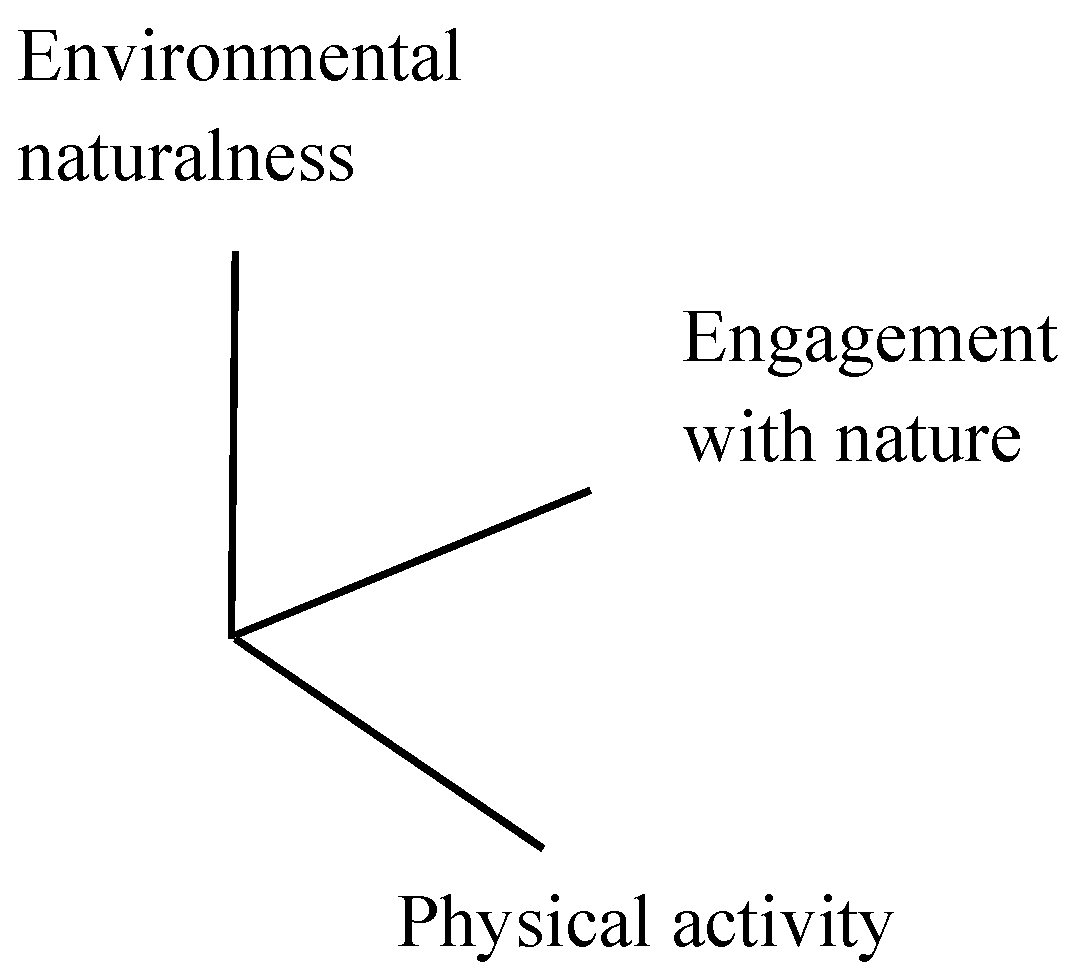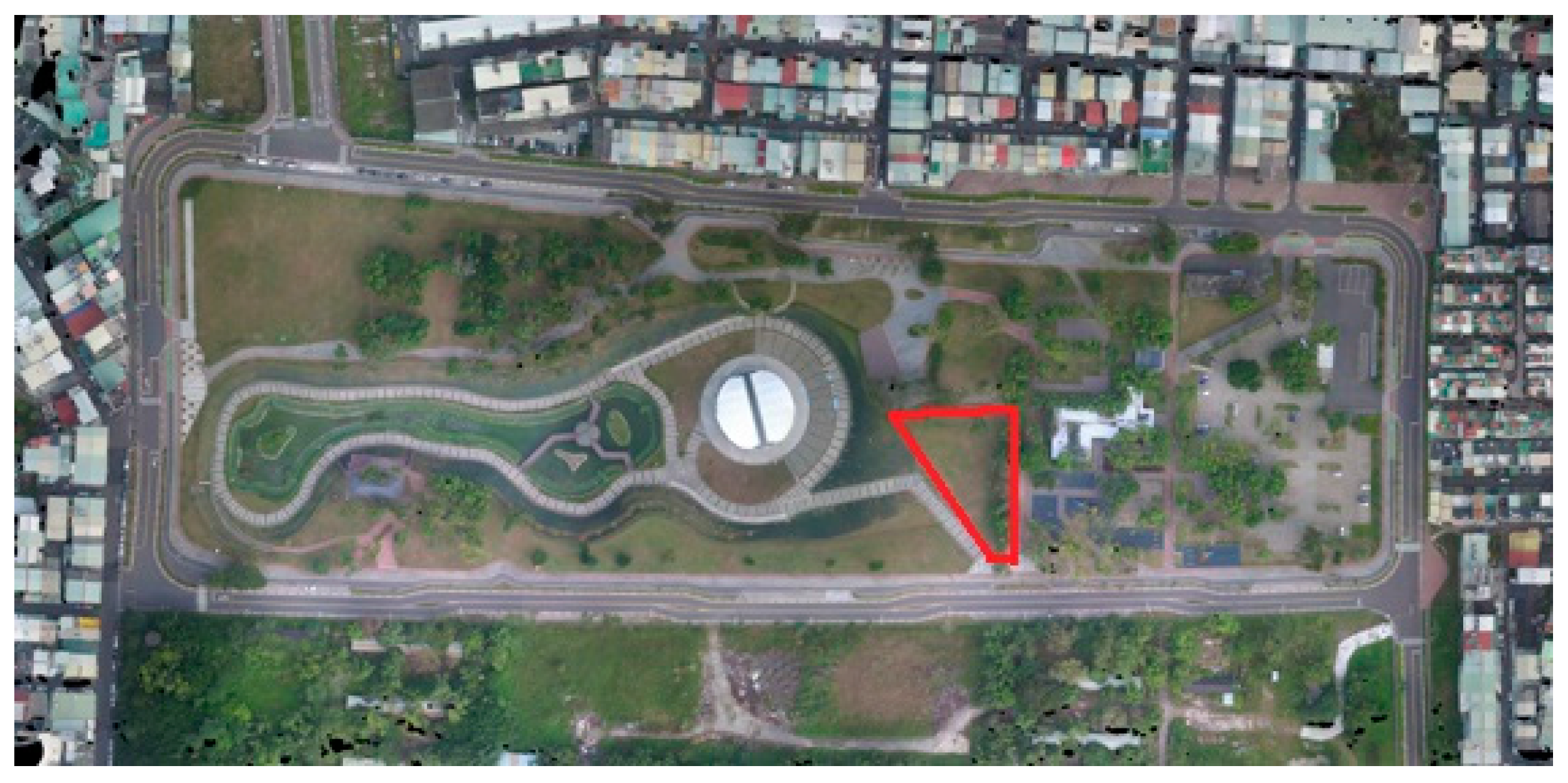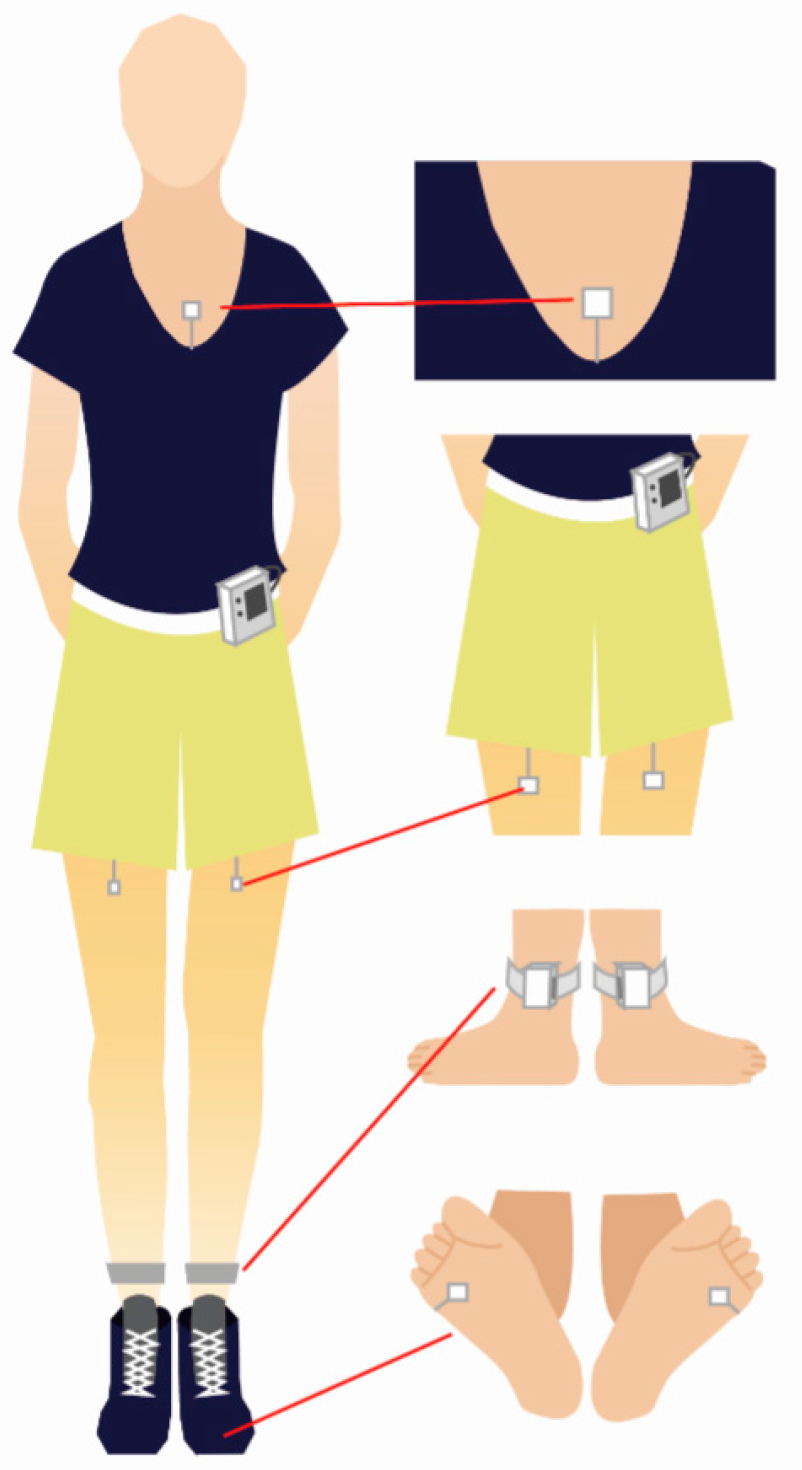Empirical Examinations of Effects of Three-Level Green Exercise on Engagement with Nature and Physical Activity
Abstract
1. Introduction
2. A Proposed Framework of Green Exercise
2.1. Environmental Naturalness
2.2. Physical Activity
2.3. Engagement with Nature
3. Research Methodology
3.1. Research Design
3.2. Research Framework and Hypotheses
3.3. Participants and Partners
3.4. Experimental Settings
3.5. Experimental Treatments
3.6. Measuring Instruments
3.6.1. Engagement with Nature
3.6.2. Physical Activity
- Bodily movement speed: This study asked each participant to wear a Garmin Forerunner 405 (New Taipei City, Taiwan), a GPS-enabled watch with a positioning accuracy of <10 m, on the nondominant hand to continuously monitor his or her location, path, and time. After the data were uploaded to ArcGIS, a geographic information system, each participant’s bodily movement speed could be calculated by dividing the total distance traveled by time.
- Arm activity: The actigraph employed in this study was the MicroMini Motionlogger Actigraph (Ambulatory Monitoring Inc., New York City, NY, USA), the appearance of which resembles a wristwatch. The device was worn on each participant’s dominant hand to measure his or her arm activity in a high proportional integral mode [42]. Generally, actigraphy features excellent validity and reliability [43,44,45,46,47].
- Limb activity and energy expenditure: This study employed the IDEEA 3 (MiniSun LLC, Fresno, CA, USA) to measure the participants’ limb activity and energy expenditure. This motion-sensing device features five biaxial accelerometers (two are wireless), which were attached to each participant’s upper torso, both thighs, and both soles with surgical Micropore tape. The data collected from these sensors were sent to a recorder worn on the waist, as shown in Figure 5. Empirical studies using the IDEEA have revealed that (1) the device can detect PA to an accuracy of ≥98% and a correlation coefficient of 0.986 between predicted and actual walking and running speeds [48]; (2) the intraclass correlation between gait and force plate measurements ranged between 0.998 (cadence) and 0.784 (step length) [49]; and (3) the IDEEA can effectively estimate energy expenditure to an accuracy of ≥95% [50].
4. Results
4.1. Engagement with Nature with Respect to Level of Green Exercise
4.2. Physical Activity with Respect to Level of Green Exercise
4.2.1. Movement Speed
4.2.2. Arm Activity
4.2.3. Limb Activity and Energy Expenditure
5. Discussion
5.1. Green Exercise Level and Engagement with Nature
5.2. Green Exercise Level and Physical Activity
5.3. Limitations and Suggestions
6. Conclusions
Acknowledgments
Author Contributions
Conflicts of Interest
References
- World Health Organization. The World Health Report 2002-Reducing Risks, Promoting Healthy Life; World Health Organization: Geneva, Switzerland, 2011; p. 61. [Google Scholar]
- World Health Organization. World Health Report; World Health Organization: Geneva, Switzerland, 2001. [Google Scholar]
- Barton, J.; Hine, R.; Pretty, J. The health benefits of walking in greenspaces of high natural and heritage value. J. Integr. Environ. Sci. 2009, 6, 261–278. [Google Scholar] [CrossRef]
- Pretty, J.; Peacock, J.; Sellengs, M.; Griffen, M. The mental and physical health outcomes of green exercise. Int. J. Environ. Health Res. 2005, 15, 319–337. [Google Scholar] [CrossRef] [PubMed]
- Mackay, G.J.S.; Neill, J.T. The effect of “green exercise” on state anxiety and the role of exercise duration, intensity, and greenness: A quasi-experimental study. Psychol. Sport Exerc. 2010, 11, 238–245. [Google Scholar] [CrossRef]
- Caspersen, C.; Powell, K.; Christensen, G. Physical activity, exercise, and physical fitness: Definitions and distinctions for health-related research. Public Health Rep. 1985, 100, 126–131. [Google Scholar] [PubMed]
- Pretty, J.; Griffin, M.; Sellens, M. Is nature good for you? Ecos 2004, 24, 2–9. [Google Scholar]
- Bird, W. Natural Thinking: Investigating the Links between the Natural Environment, Biodiversity and Mental Health; Royal Society for the Protection of Birds: Bedfordshire, UK, 2007. [Google Scholar]
- Bodin, M.; Hartig, T. Does the outdoor environment matter for psychological restoration gained through running? Psychol. Sport Exerc. 2003, 4, 141–153. [Google Scholar] [CrossRef]
- Bowler, D.E.; Buyung-Ali, L.M.; Knight, T.M.; Pullin, A.S. A systematic review of evidence for the added benefits to health of exposure to natural environments. BMC Public Health 2010, 10, 456–465. [Google Scholar] [CrossRef] [PubMed]
- Mitchell, R. Is physical activity in natural environments better for mental health than physical activity in other environments? Soc. Sci. Med. 2013, 91, 130–134. [Google Scholar] [CrossRef] [PubMed]
- Thompson Coon, J.T.; Boddy, K.; Stein, K.; Whear, R.; Barton, J.; Depledge, M.H. Does participating in physical activity in outdoor natural environments have a greater effect on physical and mental wellbeing than physical activity indoors? A systematic review. Environ. Sci. Technol. 2011, 45, 1761–1772. [Google Scholar] [CrossRef] [PubMed]
- Duvall, J. Using engagement-based strategies to alter perceptions of the walking environment. Environ. Behav. 2011, 45, 303–322. [Google Scholar] [CrossRef]
- Richardson, C.R.; Faulkner, G.; McDevitt, J.; Skrinar, G.S.; Hutchinson, D.S.; Piette, J.D. Integrating physical activity into mental health services for persons with serious mental illness. Psychiatr. Serv. 2005, 56, 324–331. [Google Scholar] [CrossRef] [PubMed]
- Johansson, M.; Hartig, T.; Staats, H. Psychological benefits of walking: Moderation by company and outdoor environment. Appl. Psychol. Health Well-Being 2011, 3, 261–280. [Google Scholar] [CrossRef]
- Kinnafick, F.E.; Thogersen-Ntoumani, C. The effect of the physical environment and levels of activity on affective states. J. Environ. Psychol. 2014, 38, 241–251. [Google Scholar] [CrossRef]
- Barton, J.; Pretty, J. What is the best dose of nature and green exercise for improving mental health? A multi-study analysis. Environ. Sci. Technol. 2010, 44, 3947–3955. [Google Scholar] [CrossRef] [PubMed]
- Harte, J.; Eifer, G.H. The effects of running, environment, and attentional focus on athletes’ catecholamine and cortisol levels and mood. Psychophysiology 1995, 32, 49–54. [Google Scholar] [CrossRef] [PubMed]
- Kaplan, R.; Kaplan, S. The Experience of Nature: A Psychological Perspective; Cambridge University Press: New York, NY, USA, 1989. [Google Scholar]
- Morgan, W.P.; Pollock, M.L. Psychological characteristics of the elite distance runner. In Annals of the New York Academy of Sciences; Milvy, P., Ed.; John Wiley & Sons: New York, NY, USA, 1977; Volume 301, pp. 382–403. [Google Scholar]
- Tenenbaum, G. A social-cognitive perspective of perceived exertion and exertion tolerance. In Handbook of Sport Psychology; Singer, R.N., Hausenblas, H., Janelle, C., Eds.; John Wiley & Sons: New York, NY, USA, 2001; pp. 810–820. [Google Scholar]
- Knopf, R.C. Human behavior, cognition, and affect in the natural environment. In Handbook of Environmental Psychology; Stokols, D., Altman, I., Eds.; John Wiley & Sons: New York, NY, USA, 1987; Volume I, pp. 783–825. [Google Scholar]
- Wohlwill, J.F. The concept of nature: A psychologist’s view. In Human Behavior and Environment: Behavior and the Natural Environment; Altman, I., Wohlwill, J.F., Eds.; Plenum Press: New York, NY, USA, 1983; Volume IV, pp. 1–34. [Google Scholar]
- Han, K.T. The effect of nature and physical activity on emotions and attention while engaging in green exercise. Urban For. Urban Green. 2017, 24, 5–13. [Google Scholar] [CrossRef]
- Junker, B.; Buchecker, M. Aesthetic preferences versus ecological objectives in river restorations. Landsc. Urban Plan. 2008, 85, 141–154. [Google Scholar] [CrossRef]
- White, E.V.; Gatersleben, B. Greenery on residential buildings: Does it affect preferences and perceptions of beauty? J. Environ. Psychol. 2011, 31, 89–98. [Google Scholar] [CrossRef]
- Bouchard, C.; Shephard, R.J. Physical activity, fitness, and health: The model and key concepts. In Physical Activity, Fitness, and Health-international Proceedings and Consensus Statement; Bouchard, C., Shephard, R.J., Stephens, T., Eds.; Humen Kinetics: Champaign, IL, USA, 1994; pp. 77–88. [Google Scholar]
- Laporte, R.E.; Montoye, H.J.; Caspersen, C.J. Assessment of physical activity in epidemiologic research: Problems and prospects. Public Health Rep. 1985, 100, 131. [Google Scholar] [PubMed]
- Burnett, C.M.; Grobe, J.L. Dietary effects on resting metabolic rate in C57BL/6 mice are differentially detected by indirect (O2/CO2 respirometry) and direct calorimetry. Mol. MeTab. 2014, 3, 460–464. [Google Scholar] [CrossRef] [PubMed]
- Ferrannini, E. The theoretical bases of indirect calorimetry: A review. Metabolism 1988, 37, 287–301. [Google Scholar] [CrossRef]
- Buchowski, M.S. Doubly labeled water is a validated and verified reference standard in nutrition research. J. Nutr. 2014, 144, 573–574. [Google Scholar] [CrossRef] [PubMed]
- Kaiyala, K.J.; Ramsay, D.S. Direct animal calorimetry, the underused gold standard for quantifying the fire of life. Comp. Biochem. Physiol. Part A Mol. Integr. Physiol. 2011, 158, 252–264. [Google Scholar] [CrossRef] [PubMed]
- Cornell, J. Sharing Nature with Children: The Classic Parents’ & Teachers’ Nature Awareness Guidebook; Dawn Publications: Nevada City, CA, USA, 1979. [Google Scholar]
- Berger, R.; McLeod, J. Incorporating nature into therapy: A framework for practice. J. Syst. Ther. 2006, 25, 80–94. [Google Scholar] [CrossRef]
- Hattie, J.; Marsh, H.W.; Neill, J.T.; Richards, G.E. Adventure education and Outward Bound: Out-of-class experiences that make a lasting difference. Rev. Educ. Res. 1997, 67, 43–87. [Google Scholar] [CrossRef]
- Campbell, M.; Cousins, M.; Farrell, G.; Kamii, M.; Lam, D.; Rugen, L.; Udall, D. The expeditionary learning outward bound design. In Bold Plans for School Restructuring; Stringfield, S., Ross, S.M., Smith, L., Eds.; Lawrence Erlbaum Associates: Mahwah, NJ, USA, 1996; pp. 109–139. [Google Scholar]
- Söderback, I.; Söderström, M.; Schälander, E. Horticultural therapy: The ‘healing garden’ and gardening in rehabilitation measures at Danderyd Hospital Rehabilitation Clinic, Sweden. Pediatr. Rehabil. 2004, 7, 245–260. [Google Scholar] [CrossRef] [PubMed]
- Stigsdotter, U.; Grahn, P. What makes a garden a healing garden. J. Ther. Hortic. 2002, 13, 60–69. [Google Scholar]
- Shadish, W.R.; Cook, T.D.; Campbell, D.T. Experimental and Quasi-Experimental Designs for Generalized Causal Inference; Houghton Mifflin Company: Boston, MA, USA, 2002. [Google Scholar]
- Park, B.J.; Furuya, K.; Kasetani, T.; Takayama, N.; Kagawa, T.; Miyazaki, Y. Relationship between psychological responses and physical environment in forest settings. Landsc. Urban Plan. 2011, 102, 24–32. [Google Scholar] [CrossRef]
- Hewson, M.L. Horticulture as Therapy: A Practical Guide to Using Horticulture as a Therapeutic Tool; Homewood Health Centre: Guelph, ON, Canada, 1994. [Google Scholar]
- Calkins, M.; Szmerekovsky, J.G.; Biddle, S. Effect of increased time spent outdoors on individuals with dementia residing in nursing homes. J. Hous. Elder. 2007, 21, 211–228. [Google Scholar] [CrossRef]
- Ancoli-Israel, S.; Cole, R.; Alessi, C.; Chambers, M.; Moorcroft, W.; Pollak, C. The role of actigraphy in the study of sleep and circadian rhythms. Sleep 2003, 26, 342–392. [Google Scholar] [CrossRef] [PubMed]
- Han, K.T.; Wang, P.T. Validity of research-grade actigraphy unit for measuring exercise intensity. Int. J. Environ. Res. Public Health 2017, 14, 511. [Google Scholar] [CrossRef] [PubMed]
- Sadeh, A. Clinical neurophysiology of sleep disorders: Actigraphy. In Handbook of Clinical Neurophysiology; Guilleminault, C., Ed.; Elsevier: Amsterdam, The Netherlands, 2005; Volume 6, pp. 67–72. [Google Scholar]
- Sadeh, A. The role and validity of actigraphy in sleep medicine: An update. Sleep Med. Rev. 2011, 15, 259–267. [Google Scholar] [CrossRef] [PubMed]
- Stone, K.L.; Ancoli-Israel, S. Actigraphy. In Principles and Practice of Sleep Medicine; Kryger, M.H., Roth, T., Dement, W.C., Eds.; Elsevier/Saunders: St. Louis, MO, USA, 2011; pp. 1668–1675. [Google Scholar]
- Zhang, K.; Werner, P.; Sun, M.; Pi-Sunyer, F.X.; Boozer, C.N. Measurement of human daily physical activity. Obes. Res. 2003, 11, 33–40. [Google Scholar] [CrossRef] [PubMed]
- Maffiuletti, N.A.; Gorelick, M.; Kramers-de Quervain, I.; Bizzini, M.; Munzinger, J.P.; Tomasetti, S.; Stacoff, A. Concurrent validity and intrasession reliability of the IDEEA accelerometry system for the quantification of spatiotemporal gait parameters. Gait Posture 2008, 27, 160–163. [Google Scholar] [CrossRef] [PubMed]
- Zhang, K.; Pi-Sunyer, F.X.; Boozer, C.N. Improving energy expenditure estimation for physical activity. Med. Sci. Sports Exerc. 2004, 36, 883–889. [Google Scholar] [CrossRef] [PubMed]
- Elliott, A.C.; Hynan, L.S. A SAS® macro implementation of a multiple comparison post hoc test for a Kruskal–Wallis analysis. Comput. Methods Programs Biomed. 2011, 102, 75–80. [Google Scholar] [CrossRef] [PubMed]
- Jubenville, A. Outdoor Recreation Management; Saunders: Philadelphia, PA, USA, 1978. [Google Scholar]
- Hartig, T.A.; Korpela, K.; Evans, G.W.; Garling, T. A measure of restorative quality in environments. Scand. Hous. Plan. Res. 1997, 14, 175–194. [Google Scholar] [CrossRef]
- Kaplan, R.; Kaplan, S.; Ryan, R.L. With People in Mind: Design and Management of Everyday Nature; Island Press: Washington, DC, USA, 1998. [Google Scholar]
- Hartig, T.A. Testing Restorative Environments Theory. Ph.D. Thesis, University of California, Irvine, CA, USA, 1993. [Google Scholar]
- DeVellis, R.F. Scale Development Theory and Applications; Sage: London, UK, 1991. [Google Scholar]
- Kaplan, R.M.; Saccuzzo, D.P. Psychological Testing: Principles, Applications, and Issues; Brooks/Cole Publishing: Pacific Grove, CA, USA, 1989. [Google Scholar]
- Kline, R.B. Principles and Practice of Structural Equation Modeling; The Guilford Press: New York, NY, USA, 1998. [Google Scholar]
- Pretty, J.; Peacock, J.; Hine, R.; Sellens, M.; South, N.; Griffen, M. Green exercise in the UK countryside: Effects on health and psychological well-being and implications for policy and planning. J. Environ. Plan. Man. 2007, 50, 211–231. [Google Scholar] [CrossRef]





| Effect | F | p | ηp2 | Treatment (n/N) b | Mean (SD) | Mean Diff. | 95% Conf. Int. for Diff. | Post-hoc | |
|---|---|---|---|---|---|---|---|---|---|
| Lower Bound | Upper Bound | ||||||||
| Treatment c × Social interaction d | 1.243 | 0.293 | 0.027 | I (33/95) | 31.61 (6.45) | I−II I−III II−III | −1.72 −7.17 −9.88 | 7.00 1.55 −1.02 | III > II (p = 0.010) |
| II (31/95) | 28.97 (8.61) | ||||||||
| Treatment (I, II, III) | 3.728 | 0.028 * | 0.077 | ||||||
| III (31/95) | 34.42 (6.53) | ||||||||
| Social interaction (Presence of partners) | 3.328 | 0.071 | 0.036 | Yes (39/95) | 33.26 (6.68) | ||||
| No (56) | 30.55 (7.90) | ||||||||
| Effect | F | p | ηp2 | Treatment (n/N) b | Mean (SD) | Mean Diff. | 95% Conf. Int. for Diff. | Post-hoc | |
|---|---|---|---|---|---|---|---|---|---|
| Lower Bound | Upper Bound | ||||||||
| Treatment c × Social interaction d | 1.810 | 0.170 | 0.039 | I (33/95) | −1.254 (0.337) | I−II I−III II−III | −0.950 −0.946 −0.154 | −0.639 −0.635 0.162 | I < II, III (p = 0.000) |
| II (31/95) | −4.598 (0.246) | ||||||||
| Treatment (I, II, III) | 94.590 | 0.000 *** | 0.680 | ||||||
| III (31/95) | −4.639 (0.141) | ||||||||
| Social interaction (Presence of partners) | 0.097 | 0.757 | 0.001 | Yes (39/95) | −0.715 (0.368) | ||||
| No (56) | −0.753 (0.511) | ||||||||
| Treatment a | ΣR b | p | Post-hoc | Sig. | ||
|---|---|---|---|---|---|---|
| I | 683 | 20.697 | 51.666 | 0.000 | N | |
| II | 1435 | 46.290 | N | |||
| III | 1502 | 48.451 | Y |
| Variable | Effect | F | P | ηp2 | Treatment (n/N) | Mean (SD) | Mean Diff. | 95% Conf. Int. for Diff. | Post-hoc | |
|---|---|---|---|---|---|---|---|---|---|---|
| Lower Bound | Upper Bound | |||||||||
| Upstair/downstair momentum | Treatment b × Social interaction c | 0.314 | 0.578 | 0.005 | II (31/95) | 84.300 (22.764) | II−III | 6.442 | 30.177 | III < II (p = 0.003) |
| Treatment (I, II, III) | 9.538 | 0.003 ** | 0.141 | III (31/95) | 66.526 (23.222) | |||||
| Social interaction (Presence of partner) | 1.470 | 0.230 | 0.025 | Yes (26/62) | 71.238 (25.625) | |||||
| No (36/62) | 78.428 (23.558) | |||||||||
| Upstair/downstair calorimetry | Treatment b × Social interaction c | 0.077 | 0.783 | 0.001 | II (31/95) | 4.378 (1.383) | II−III | 0.215 | 1.558 | III < II (p = 0.011) |
| Treatment (I, II, III) | 6.977 | 0.011 * | 0.107 | III (31/95) | 3.506 (1.223) | |||||
| Social interaction (Presence of partner) | 2.114 | 0.151 | 0.035 | Yes (26/62) | 3.659 (1.377) | |||||
| No (36/62) | 4.147 (1.343) | |||||||||
| Number of posture transitions | Treatment b × Social interaction c | 3.708 | 0.059 | 0.060 | II (31/95) | 4.650 (5.364) | II−III | −12.799 | 0.013 | II < III (p = 0.050) |
| Treatment (I, II, III) | 3.99 | 0.050 | 0.064 | III (31/95) | 12.030 (17.209) | |||||
| Social interaction (Presence of partner) | 1.334 | 0.253 | 0.022 | Yes (26/62) | 6.190 (7.250) | |||||
| No (36/62) | 9.890 (16.101) | |||||||||
| Number of sitting posture | Treatment b × Social interaction c | 4.246 | 0.044 * | 0.068 | II (31/95) | 10.260 (11.081) | II−II | −18.324 | −2.539 | II < III (p = 0.010) |
| Treatment (I, II, III) | 7.00 | 0.010 ** | 0.108 | III (31/95) | 22.000 (19.313) | |||||
| Social interaction (Presence of partner) | 1.133 | 0.292 | 0.019 | Yes (26/62) | 13.690 (14.507) | |||||
| Interaction (No partner) | 12.565 | 0.001 *** | 0.270 | No (36/62) | 17.890 (18.114) | |||||
| II (No partner) (18/36) | 8.611 (11.126) | II−III | −29.194 | −7.918 | II < III (p = 0.001) | |||||
| III (No partner) (18/36) | 27.167 (19.221) | |||||||||
© 2018 by the authors. Licensee MDPI, Basel, Switzerland. This article is an open access article distributed under the terms and conditions of the Creative Commons Attribution (CC BY) license (http://creativecommons.org/licenses/by/4.0/).
Share and Cite
Han, K.-T.; Wang, P.-C. Empirical Examinations of Effects of Three-Level Green Exercise on Engagement with Nature and Physical Activity. Int. J. Environ. Res. Public Health 2018, 15, 375. https://doi.org/10.3390/ijerph15020375
Han K-T, Wang P-C. Empirical Examinations of Effects of Three-Level Green Exercise on Engagement with Nature and Physical Activity. International Journal of Environmental Research and Public Health. 2018; 15(2):375. https://doi.org/10.3390/ijerph15020375
Chicago/Turabian StyleHan, Ke-Tsung, and Po-Ching Wang. 2018. "Empirical Examinations of Effects of Three-Level Green Exercise on Engagement with Nature and Physical Activity" International Journal of Environmental Research and Public Health 15, no. 2: 375. https://doi.org/10.3390/ijerph15020375
APA StyleHan, K.-T., & Wang, P.-C. (2018). Empirical Examinations of Effects of Three-Level Green Exercise on Engagement with Nature and Physical Activity. International Journal of Environmental Research and Public Health, 15(2), 375. https://doi.org/10.3390/ijerph15020375




